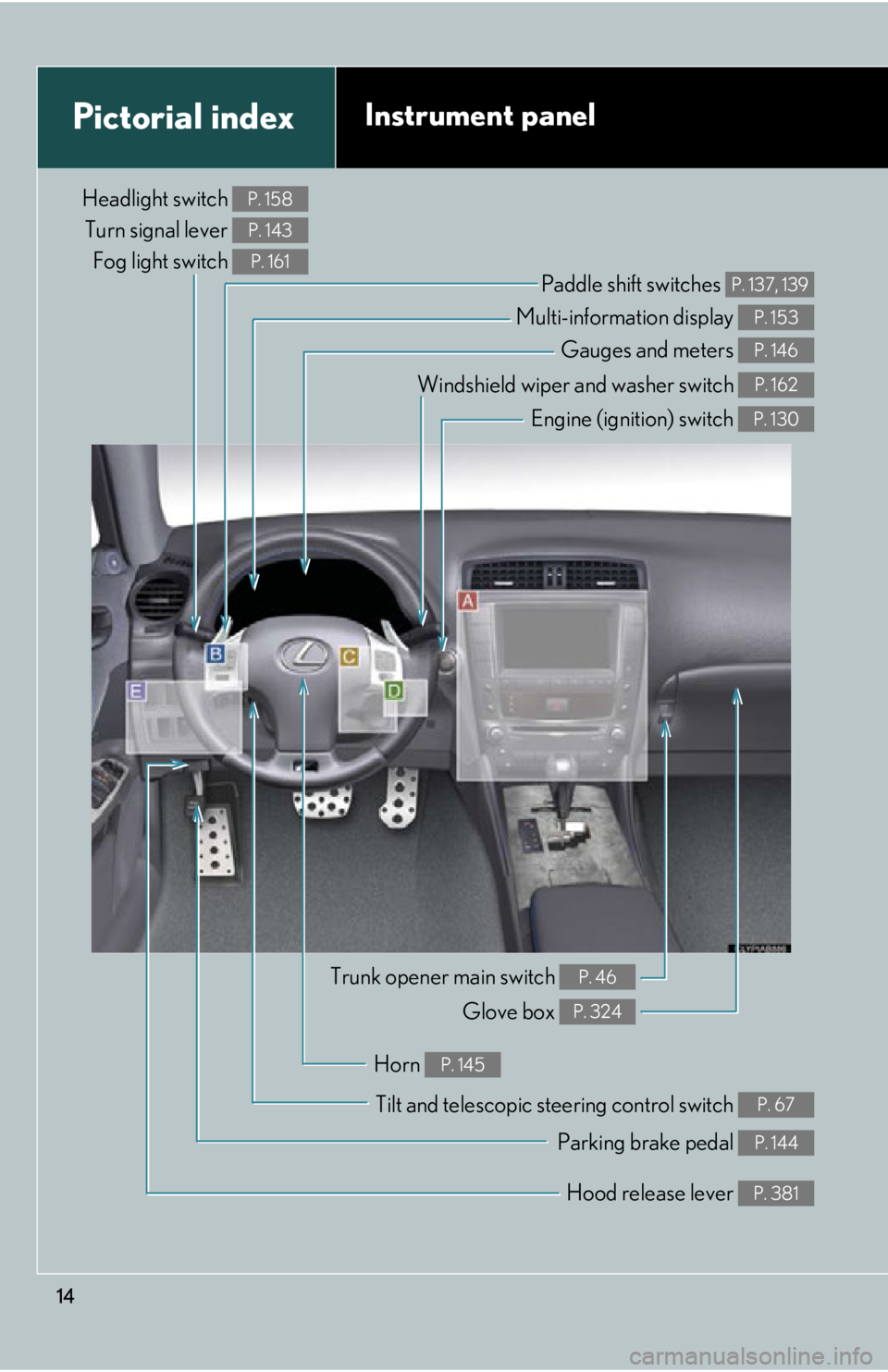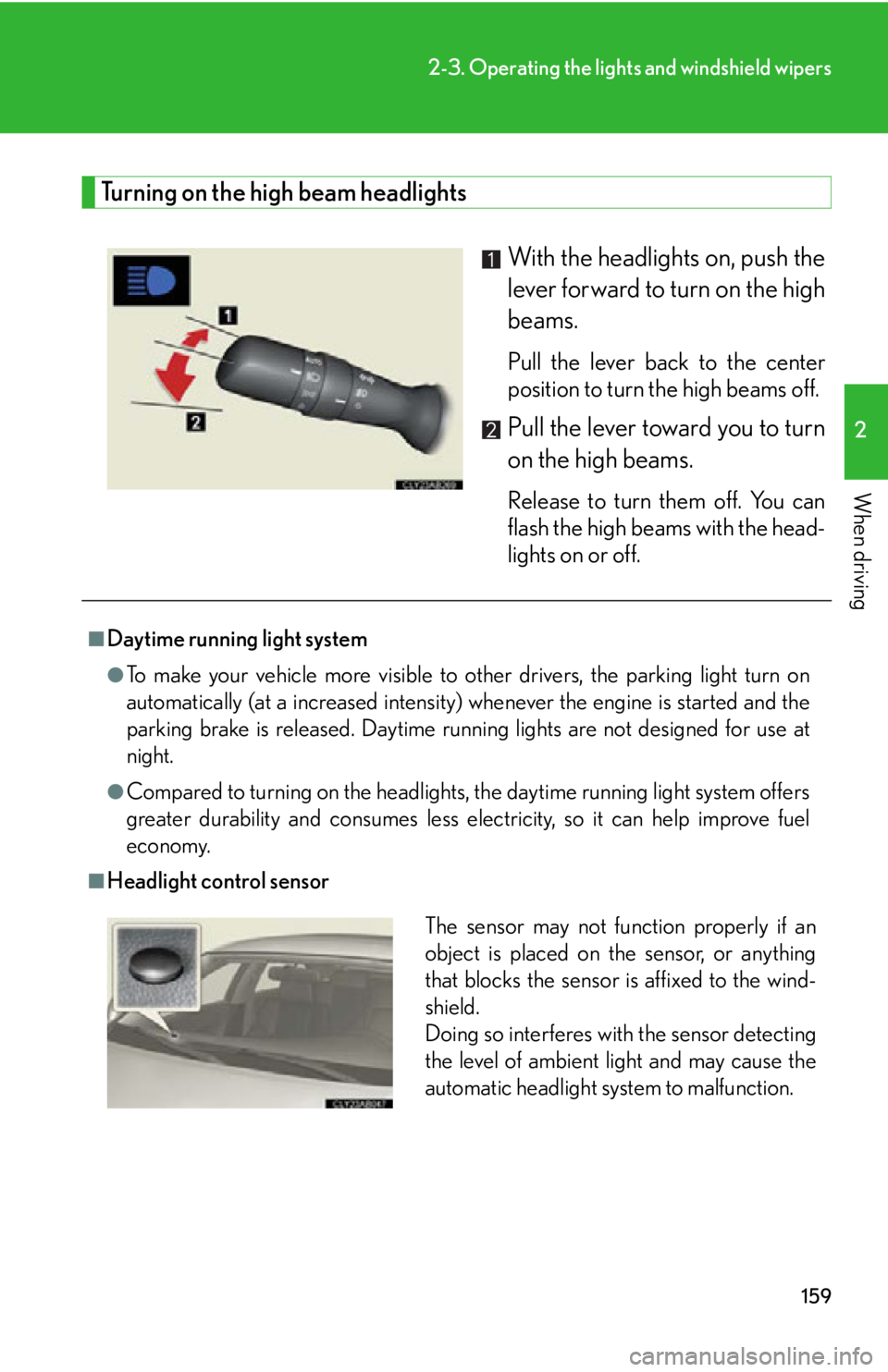brake light Lexus IS F 2011 Using The Bluetooth Audio System /
[x] Cancel search | Manufacturer: LEXUS, Model Year: 2011, Model line: IS F, Model: Lexus IS F 2011Pages: 568, PDF Size: 7.03 MB
Page 3 of 568

1
2
3
4
5
6
7
3
2-1. Driving proceduresDriving the vehicle ........................ 122
Engine (ignition) switch .............. 130
Automatic transmission.............. 134
Turn signal lever ............................ 143
Parking brake ................................. 144
Horn.................................................... 145
2-2. Instrument cluster Gauges and meters ..................... 146
Indicators and warning lights................................................. 150
Multi-information display........... 153
2-3. Operating the lights and windshield wipers
Headlight switch ............................ 158
Fog light switch ................................ 161
Windshield wipers and washer............................................. 162
Headlight cleaner switch ........... 165
2-4. Using other driving systems Cruise control ................................ 166
Dynamic radar cruise control............................................. 169
Intuitive parking assist .................. 181
Driving assist systems.................. 187
PCS (Pre-Collision System) ............ 193 2-5. Driving information
Cargo and luggage .................... 200
Vehicle load limits ........................ 203
Winter driving tips ....................... 204
Trailer towing ................................. 206
Dinghy towing ............................... 207
3-1. Using the air conditioning system and defogger
Automatic air conditioning system ............................................. 210
Rear window and outside rear view
mirror defoggers ........................ 218
Windshield wiper de-icer .......... 219
3-2. Using the audio system Audio system type ....................... 220
Using the radio.............................. 223
Using the CD player.................... 231
Playing back MP3 and WMA discs.................................. 238
Operating an iPod....................... 246
Operating a USB memory....... 254
Optimal use of the audio system ............................................ 263
Using the AUX port ................... 265
Using the steering wheel audio switches ............................ 267
2When driving
3Interior features
Page 14 of 568

14
Multi-information display P. 153
Pictorial indexInstrument panel
Headlight switch Turn signal lever Fog light switch P. 158
P. 143
P. 161
Paddle shift switches P. 137, 139
Gauges and meters P. 146
Windshield wiper and washer switch P. 162
Engine (ignition) switch P. 130
Trunk opener main switch P. 46
Glove box P. 324
Tilt and telescopic steering control switch P. 67
Parking brake pedal P. 144
Hood release lever P. 381
Horn P. 145
Page 121 of 568

When driving2
121
2-1. Driving proceduresDriving the vehicle.................. 122
Engine (ignition) switch ......... 130
Automatic transmission ........ 134
Turn signal lever ....................... 143
Parking brake ........................... 144
Horn ............................................ 145
2-2. Instrument cluster Gauges and meters ................ 146
Indicators and warning lights ......................................... 150
Multi-information display ..... 153
2-3. Operating the lights and windshield wipers
Headlight switch...................... 158
Fog light switch ......................... 161
Windshield wipers and washer ..................................... 162
Headlight cleaner switch...... 165 2-4. Using other driving
systems
Cruise control.......................... 166
Dynamic radar cruise control ...................................... 169
Intuitive parking assist ............ 181
Driving assist systems ............ 187
PCS (Pre-Collision System) ....... 193
2-5. Driving information Cargo and luggage ............... 200
Vehicle load limits .................. 203
Winter driving tips ................. 204
Trailer towing .......................... 206
Dinghy towing ......................... 207
Page 124 of 568

124
2-1. Driving procedures
CAUTION
■When starting off
To prevent the vehicle from creeping forward, keep the brake pedal firmly
depressed when shifting the shift lever.
■When driving the vehicle
●Do not drive if you are unfamiliar with the location of the brake and accelerator
pedals to avoid depressing the wrong pedal.
• Accidentally depressing the accelerator pedal instead of the brake pedal will
result in sudden acceleration that may le ad to an accident that could result in
death or serious injury.
• When backing up, you may twist your bo dy around, leading to a difficulty in
operating the pedals. Make sure to operate the pedals properly.
• Make sure to keep a correct driving posture even when moving the vehicle only slightly, allowing you to depress the brake and accelerator pedals prop-
erly.
• Depress the brake pedal using your right foot. Depressing the brake pedal using your left foot may delay response in an emergency, resulting in an acci-
dent.
●Do not drive the vehicle over or stop the vehicle near flammable materials.
●Do not let the vehicle roll backwards while the shift lever is in a driving position, or
roll forward while the shift lever is in R.
Doing so may cause the engine to stall or lead to poor brake and steering perfor-
mance, resulting in an accident or damage to the vehicle.
●If the smell of exhaust is noticed inside the vehicle, open the windows and check
that the trunk is closed. Large amounts of exhaust in the vehicle can cause driver
drowsiness and an accident, resulting in death or a serious health hazard. Have
the vehicle inspected by your Lexus dealer immediately.
●Do not under any circumstances shift the sh ift lever to P, R or N while the vehicle
is moving.
Doing so can cause significant damage to the transmission system and may result
in a loss of vehicle control.
●Do not shift the shift lever to N while the vehicle is moving.
Doing so may cause the engine brake to not operate properly and lead to an
accident.
Page 125 of 568

125
2-1. Driving procedures
2
When driving
CAUTION
●Do not turn the engine off while driving.
The power steering and brake booster systems will not operate properly if the
engine is not running.
●Use engine braking (downshift) to maintain a safe speed when driving down a
steep hill.
Using the brakes continuously may cause the brakes to overheat and lose effec-
tiveness. (P. 137, 139)
●When stopped on an inclined surface, use the brake pedal and parking brake to
prevent the vehicle from rolling backward or forward and causing an accident.
●Do not adjust the position of the steering wheel, the seat, or the inside or outside
rear view mirrors while driving.
Doing so may result in a loss of vehicle control that can cause accidents that may
result in death or serious injury.
●Always check that all passengers' arms, heads or other parts of their bodies are
not outside the vehicle, as this may result in death or serious injury.
●Do not drive in excess of the speed limit. Even if the legal speed limit permits it, do
not drive over 85 mph (140 km/h) unless your vehicle has high-speed capability
tires. Driving over 85 mph (140 km/h) may result in tire failure, loss of control and
possible injury. Be sure to consult a tire dealer to determine whether the tires on
your vehicle are high-speed capability tires or not before driving at such speeds.
■When driving on slippery road surfaces
●Sudden braking, acceleration and steering may cause tire slippage and reduce
your ability to control the vehi cle, resulting in an accident.
●Sudden changes in engine speed, such as engine braking caused by up-shifting
or down-shifting, may cause the vehicl e to skid, resulting in an accident.
●After driving through a puddle, lightly depress the brake pedal to make sure that
the brakes are functioning properly. Wet brake pads may prevent the brakes from
functioning properly. If the brakes on on ly one side are wet and not functioning
properly, steering control may be af fected, resulting in an accident.
■When shifting the shift lever
Be careful not to shift the shift lever with the accelerator pedal depressed.
This may lead to unexpected rapid acceleration of the vehicle that may cause an
accident and result in death or serious injury.
Page 126 of 568

126
2-1. Driving procedures
CAUTION
■When the vehicle is stopped
●Do not race the engine.
If the vehicle is in any gear other than P or N, the vehicle may accelerate suddenly
and unexpectedly, and may cause an accident.
●Do not leave the vehicle with the engine running for a long time.
If such a situation cannot be avoided, park the vehicle in an open space and
check that exhaust fumes do not enter the vehicle interior.
●In order to prevent accidents due to the vehicle rolling away, always keep
depressing the brake pedal while the en gine is running, and apply the parking
brake as necessary.
●If the vehicle is stopped on an incline, in order to prevent accidents caused by the
vehicle rolling forward or backward, always depress the brake pedal and securely
apply the parking brake as needed.
●Avoid revving or racing the engine.
Running the engine at high speed while the vehicle is stopped may cause the
exhaust system to overheat, which could result in a fire if combustible material is
nearby.
■When the vehicle is parked
●Do not leave glasses, cigarett e lighters, spray cans, or soft drink cans in the vehi-
cle when it is in the sun.
Doing so may result in the following.
• Gas may leak from a cigarette lighter or spray can, and may lead to a fire.
• The temperature inside the vehicle may cause the plastic lenses and plastic
material of eye glasses to deform or crack.
• Soft drink cans may fracture, causing the contents to spray over the interior of
the vehicle, and may also cause a short circuit in the vehicle's electrical com-
ponents.
●Always apply the parking brake, shift the shift lever to P, stop the engine and lock
the vehicle.
Do not leave the vehicle unattend ed while the engine is running.
●Do not touch the exhaust pipes or rear bumper exhaust diffusers while the engine
is running or immediately af ter turning the engine off.
Doing so may cause burns.
Page 159 of 568

159
2-3. Operating the lights and windshield wipers
2
When driving
Turning on the high beam headlights
With the headlights on, push the
lever forward to turn on the high
beams.
Pull the lever back to the center
position to turn the high beams off.
Pull the lever toward you to turn
on the high beams.
Release to turn them off. You can
flash the high beams with the head-
lights on or off.
■Daytime running light system
●To make your vehicle more visible to other drivers, the parking light turn on
automatically (at a increased intensity) whenever the engine is started and the
parking brake is released. Daytime running lights are not designed for use at
night.
●Compared to turning on the headlights, the daytime running light system offers
greater durability and consumes less electricity, so it can help improve fuel
economy.
■Headlight control sensor
The sensor may not function properly if an
object is placed on the sensor, or anything
that blocks the sensor is affixed to the wind-
shield.
Doing so interferes with the sensor detecting
the level of ambient light and may cause the
automatic headlight system to malfunction.
Page 167 of 568

167
2-4. Using other driving systems
2
When driving
■Cruise control can be set when
●The shift lever is in the D position. However, it cannot be set if any of the ranges 1
through 3 has been selected using the paddle shift switches.
●Vehicle speed is more than approximately 24 mph (40 km/h).
■Adjusting the speed setting
Increase speed
Decrease speed
Hold the lever until the desired
speed setting is obtained.
Fine adjustment of the set
speed (approximately 1.0 mph
[1.6 km/h]) can be made by
lightly pressing the lever up or
down and releasing it.
■Canceling and resuming regular acceleration
Cancel
Push the lever towards you to
cancel cruise control.
The speed setting is also can-
celed when the brakes are
applied.
Resume
To resume cruise control and
return to the set speed, push the
lever up.
Page 171 of 568

171
2-4. Using other driving systems
2
When driving
■Adjusting the speed setting
Increase speed
Decrease speed
Hold the lever until the desired
speed setting is displayed.
Fine adjustment of the set speed
can be made by lightly pressing
the lever up or down and releas-
ing it. Adjustment can be made
in increments of approximately
1.0 mph (1.6 km/h) when in the
constant speed control mode,
and approximately 5.0 mph/5.0
km/h when in vehicle-to-vehi-
cle distance control mode.
■Canceling and resuming the speed setting
Cancel
Push the lever towards you to
cancel cruise control.
The setting is also canceled
when the brakes are applied.
Resume
To resume cruise control and
return to the set speed, push the
lever up.
Page 174 of 568

174
2-4. Using other driving systems
Example of follow-up cruising
When following a vehicle driving slower than the set speed
The system continues follow-up cruising while adjusting for changes in the
speed of the vehicle ahead in order to maintain the vehicle-to-vehicle dis-
tance set by the driver.
Example of acceleration
When there are no longer vehicles driving slower than the set speed
in the lane ahead
When the vehicle ahead of you executes a lane change, the system slowly
accelerates until the set vehicle speed is reached. The system then returns to
fixed speed cruising.
Approach warning
When your vehicle is too close to a vehicle ahead, and sufficient auto-
matic deceleration via th e cruise control is not po ssible, the display will
flash and buzzer will sound to alert th e driver. An example of this would
be if another driver cuts in front of you while you are following a vehicle.
Apply the brakes to ensure an appr opriate vehicle-to-vehicle distance.
■Warning lights, messages and buzzer s for dynamic radar cruise control
Warning lights, messages and buzzers are us ed to indicate a system malfunction or
to inform the driver of the need for caution while driving. ( P. 4 6 3 )
■Switching modes
The mode cannot be switched to constant speed control mode if vehicle-to-vehicle
distance control mode has been used. Th e mode also cannot be switched from
constant speed control to vehicle-to-vehic le distance control mode. Turn the sys-
tem off by pressing the “ON-OFF” button, and turn it on again.
■The dynamic radar cruise can be set when
●The shift lever is in the D position. However, it cannot be set if any of the ranges 1
through 3 has been selected using the paddle shift switches.
●Vehicle speed is more than approximately 30 mph (50 km/h).